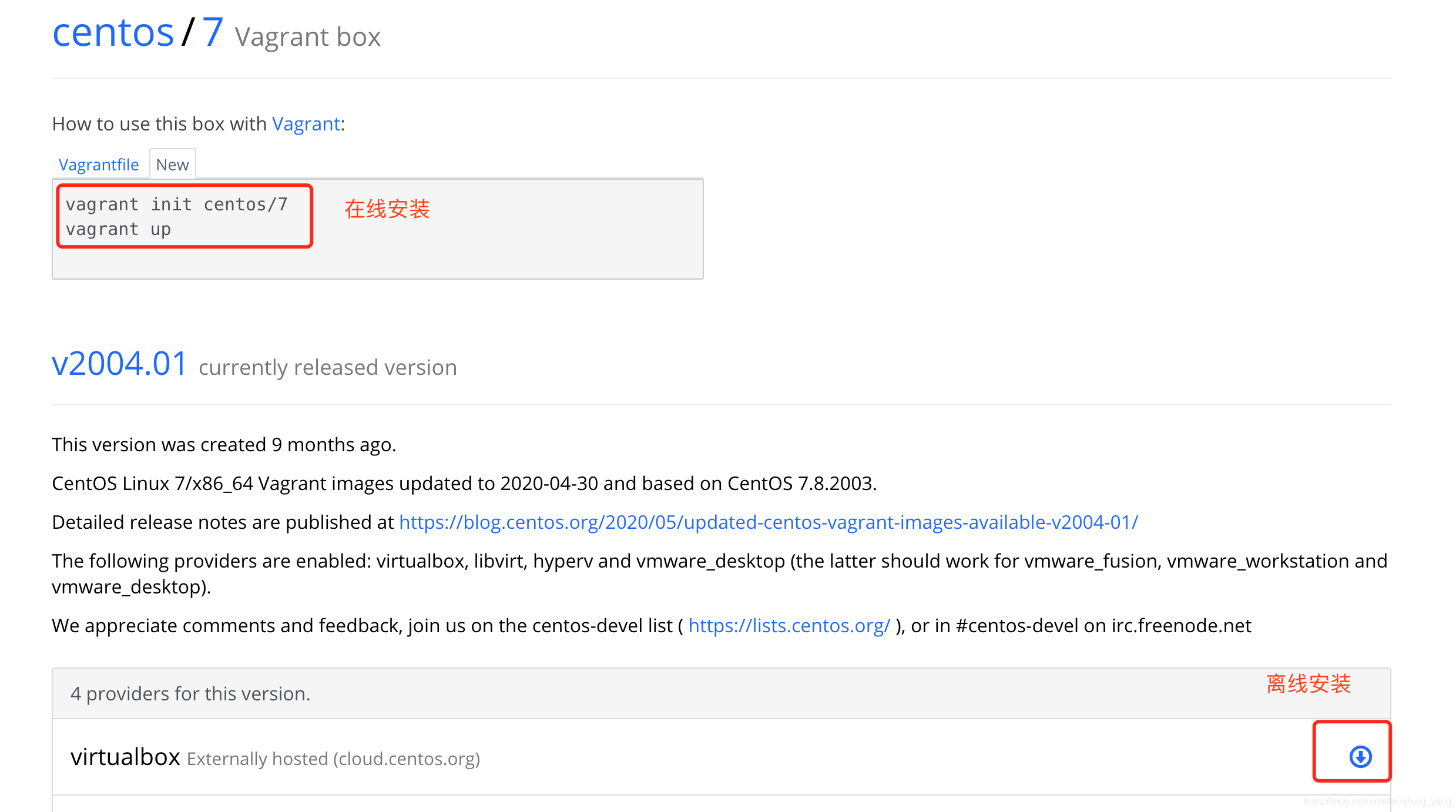您好,登錄后才能下訂單哦!
您好,登錄后才能下訂單哦!
這篇文章將為大家詳細講解有關利用vagrant和virtualBox怎么構建一個虛擬機,文章內容質量較高,因此小編分享給大家做個參考,希望大家閱讀完這篇文章后對相關知識有一定的了解。
Vagrant是一個構建和管理虛擬機(VirtualBox)的工具。
VirtualBox: https://www.virtualbox.org/wiki/Downloads
Vagrant: http://downloads.vagrantup.co
1.在官網找到自己想要安裝的操作系統:https://app.vagrantup.com/boxes/search

2.點進去,執行命令創建并啟動虛擬機:https://app.vagrantup.com/centos/boxes/7

注意:需要單獨創建一個目錄,在該目錄下執行vagrant命令,一個目錄對應一個虛擬機。vagrant init會創建一個配置文件Vagrantfile
1.添加
vagrant box add centOs7 /Users/xianbin.yang/Documents/vagrant/centos-7.0-x86_64.box
? vagrant vagrant box add centOs7 /Users/xianbin.yang/Documents/vagrant/centos-7.0-x86_64.box ==> box: Box file was not detected as metadata. Adding it directly... ==> box: Adding box 'centOs7' (v0) for provider: box: Unpacking necessary files from: file:///Users/xianbin.yang/Documents/vagrant/centos-7.0-x86_64.box ==> box: Successfully added box 'centOs7' (v0) for 'virtualbox'!
2.初始化
vagrant init centOs7
? vagrant vagrant init centOs7 A `Vagrantfile` has been placed in this directory. You are now ready to `vagrant up` your first virtual environment! Please read the comments in the Vagrantfile as well as documentation on `vagrantup.com` for more information on using Vagrant.
3.啟動
vagrant up
? vagrant vagrant up Bringing machine 'default' up with 'virtualbox' provider... ==> default: Importing base box 'centOs7'... ==> default: Matching MAC address for NAT networking... ==> default: Setting the name of the VM: vagrant_default_1612583375721_1893 ==> default: Clearing any previously set forwarded ports... ==> default: Clearing any previously set network interfaces... ==> default: Preparing network interfaces based on configuration... default: Adapter 1: nat ==> default: Forwarding ports... default: 22 (guest) => 2222 (host) (adapter 1) ==> default: Booting VM... ==> default: Waiting for machine to boot. This may take a few minutes... default: SSH address: 127.0.0.1:2222 default: SSH username: vagrant default: SSH auth method: private key default: default: Vagrant insecure key detected. Vagrant will automatically replace default: this with a newly generated keypair for better security. default: default: Inserting generated public key within guest... default: Removing insecure key from the guest if it's present... default: Key inserted! Disconnecting and reconnecting using new SSH key... ==> default: Machine booted and ready! ==> default: Checking for guest additions in VM... default: The guest additions on this VM do not match the installed version of default: VirtualBox! In most cases this is fine, but in rare cases it can default: prevent things such as shared folders from working properly. If you see default: shared folder errors, please make sure the guest additions within the default: virtual machine match the version of VirtualBox you have installed on default: your host and reload your VM. default: default: Guest Additions Version: 4.3.28 default: VirtualBox Version: 6.1 ==> default: Mounting shared folders... default: /vagrant => /Users/xianbin.yang/Documents/vagrant
| 命令 | 作用 |
|---|---|
| vagrant box add | 添加box的操作 |
| vagrant init | 初始化box的操作,會生成vagrant的配置文件Vagrantfile |
| vagrant up | 啟動本地環境 |
| vagrant ssh | 通過 ssh 登錄本地環境所在虛擬機 |
| vagrant halt | 關閉本地環境 |
| vagrant suspend | 暫停本地環境 |
| vagrant resume | 恢復本地環境 |
| vagrant reload | 修改了 Vagrantfile 后,使之生效(相當于先 halt,再 up) |
| vagrant destroy | 徹底移除本地環境 |
| vagrant box list | 顯示當前已經添加的box列表 |
| vagrant box remove | 刪除相應的box |
| vagrant status | 獲取當前虛擬機的狀態 |
1.配置固定ip、內存、cpu
# -*- mode: ruby -*-
# vi: set ft=ruby :
Vagrant.configure("2") do |config|
config.vm.box = "centOs7"
config.vm.network "private_network", ip: "192.168.33.10"
config.vm.provider "virtualbox" do |vb|
vb.cpus = 4
vb.memory = "8192"
end
end注意:配置后需要vagrant reload
2.配置root用戶和ssh免密
vagrant用戶登錄:vagrant ssh
設置root密碼:sudo passwd root
配置ssh免密:ssh-copy-id root@192.168.33.10
ssh登錄:ssh root@192.168.33.10
3.關閉防火墻
檢查防火墻狀態:systemctl status firewalld
關閉防火墻:systemctl stop firewalld
設置開機禁用防火墻:systemctl disable firewalld.service
關于利用vagrant和virtualBox怎么構建一個虛擬機就分享到這里了,希望以上內容可以對大家有一定的幫助,可以學到更多知識。如果覺得文章不錯,可以把它分享出去讓更多的人看到。
免責聲明:本站發布的內容(圖片、視頻和文字)以原創、轉載和分享為主,文章觀點不代表本網站立場,如果涉及侵權請聯系站長郵箱:is@yisu.com進行舉報,并提供相關證據,一經查實,將立刻刪除涉嫌侵權內容。